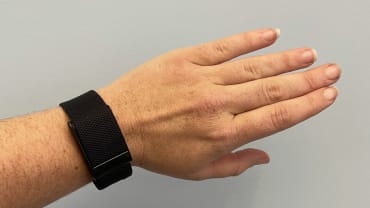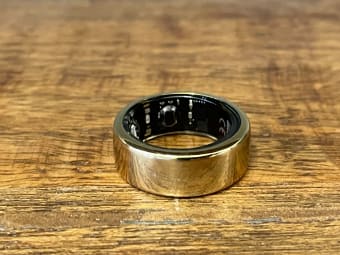Everyone will have a different baseline, but when it comes to optimizing your body’s performance, the general goal is to increase your heart rate variability over time. A lower HRV has been linked with diabetes, cardiovascular disease, inflammation, obesity, and psychiatric disorders2, but increasing your HRV helps to calm down your body, minimize stress1, and improve sleep, digestion, concentration, and ultimately, your vitality. Sign us up for all of the above. Today, there are trackers to monitor your heart while you sleep, work out, and anywhere in between. “A chest strap is commonly used to gather this data, but there are now fitness trackers that are worn on the wrist or finger that can capture and calculate heart rate variability,” says Sanul Corrielus, M.D., board-certified cardiologist and author of Healing the Spartan. To help you gain a better understanding of how aspects like diet, nutrition, exercise, and sleep are affecting your heart rate variability (and your body’s performance), we hunted down the best HRV monitors on the market today—so you can take your health into your own hands. “Heart rate variability is a measurement of the balance between your sympathetic and parasympathetic branches of your autonomic nervous system,” explains board-certified cardiologist Michael Twyman, M.D. “Low heart rate variability is associated with increased stress and lower parasympathetic tone, while high heart rate variability is associated with decreased stress and higher parasympathetic tone.” Corrielus adds that your HRV can provide valuable insights into your overall health and well-being. “If your heart rate is highly variable, it indicates that your body is highly adaptable to where you are and what you are doing,” he says. “People who are happy and less stressed have a higher heart rate variability. Similarly, those who are stressed and unsettled tend to have higher heart rate and a low heart rate variability.” If you’re used to referencing higher heart rate as a sign of stress, the concept of high HRV as a good thing can be a bit confusing. Remember: High variability means you’re highly adaptable or, in other words, ready to take on whatever life throws at you. Below are a few key insights you can gain from keeping tabs on your heart rate variability: Athletic performance and overtraining: HRV has been long recommended as a tool to warn of overtraining and to optimize performance in athletes of all levels4. Some HRV monitors even send you notifications when you’re pushing it too far, which can help prevent injury and stress. Sickness: A downward trend in HRV can signal that you’re not getting adequate sleep or that your immune system is weakened. “A decrease in heart rate variability is sometimes an early warning sign that you are about to be sick,” Twyman confirms. Stress: Research suggests that fleeting stressful moments, such as making time-sensitive decisions, public speaking, or test-taking, can significantly decrease HRV5. Monitoring your HRV gives you more awareness during these situations so you can properly seek out tools for coping with this acute stress. “There are no dangers or significant downsides in measuring your heart rate variability,” Twyman confirms. He does, however, note that your HRV is very personal, and it’s best to always compare it to your baseline versus someone else’s. “Heart rate variability can be a good tool to help gauge your health—but just like any other tool, it has to be used cautiously,” agrees Corrielus. “While there is no danger in monitoring HRV, the information has to be checked for accuracy, depending on the device’s use (some are more reliable than others), and the information has to be put into the context of the full clinical picture.” If you have any concerns about your heart health or the data you’re seeing from a wearable tracker, it’s always best to consult your doctor. Activity & durability: Some trackers are simply more durable than others. For example, the Apple Watch has come a long way with its durability, but a cracked screen from a collision or high fall is still a big bummer. Ultimately, the best device for you will depend on what you’re using it for. For example, if you’re hoping to track your HRV through activities like swimming, you’ll need something waterproof. Where you’ll wear it: Rings are easy to sleep with but might not be best for lifting weights. Watches are great for daytime use but could feel clunky to sleep with. Chest straps are great for exercise, but it’s unlikely you’ll want to wear one out and about all day (or to sleep, for that matter). Cost: Consider how much you want to spend on your tracker and whether you’d prefer it be a one-time purchase or if you’re willing to pay a subscription fee every month. Some devices (like WHOOP) require a monthly payment but have no upfront cost. Others (like the Fitbit Inspire 3) have a low upfront cost but still require a monthly payment to get the most data out of your device. Your HRV is monitored through the “Recovery” tab, along with a newer feature, the “Health Monitor,” which identifies your typical heart rate, resting heart rate, heart-rate variability, skin temperature, and blood oxygen levels. Your wristband will even send alerts when you deviate from your standard levels. A hands-on take from the writer: “I wore the WHOOP 3.0 for about a year. I loved the intuitive platform and how much data there was to peruse every day. It also just looks cool and is really comfortable to wear. One thing that got in my way, though, was the psychological factor of the Strain and Recovery scores. I didn’t love the few days that my mental state (I’m ready to work out!) didn’t match what the app was telling me (you actually need to recover). I also don’t love sleeping in wearable devices, which is key for getting the most accurate, robust data about your recovery. That being said, I love that the 4.0 is 33% smaller than the last model I wore—which was already pretty sleek!” Other features include automatic activity tracking for over 30 types of activity, menstrual cycle tracking through your body temperature, and a “Rest Mode” feature, which lets you opt out of tracking on days when you’re sick or overly stressed (although this information can be helpful to know!). A hands-on take from the writer: “I tried out the Oura Ring a while back, and it’s really impressive. The data, especially from sleep, is extremely thorough while still being user-friendly for the average human, like me. While the platform is really cool, I stopped wearing it because I’m a runner and I prefer a tracker with a face. I also have smaller hands (I’m 5'3”) and the ring felt clunky—I might have gotten used to it if I committed to wearing it more, though." The strap can be connected to your smartphone, broadcast to equipment through Bluetooth, and synced with your favorite fitness apps. All metrics are viewable via the free corresponding app, and through the brand’s smartwatch (sold separately). It also pairs with most other trackers, regardless of the brand. With up to 400 hours of battery life, this strap gets great reviews from athletes of all levels for reliable data and a comfortable fit. The only potential downside is that this strap is intended to be worn during activity versus 24/7, so you’ll likely not want to wear it to work or sleep. While it is geared toward runners, you don’t need to be training for a race to reap the benefits of this watch. Additional noteworthy features include: access to your calendar, phone notifications, and contactless payments. With the Forerunner 255’s “Morning Report,” it’s easy to get a view of your overnight HRV and recovery status on the watch itself (assuming you slept with it on) or by using the brand’s free app (for a deeper dive). It’s also available in two different case sizes and a few different color options. Hands-on take from the writer: “I wear and run in the Forerunner 245, a slightly different model, and I really love it. It’s a great tracker with solid battery life, reliable GPS, and an intuitive interface. Unfortunately, the 245 doesn’t have the same HRV monitoring as the 255, so I can’t speak to that feature. It’s also a larger watch to sleep in for smaller folks (I don’t sleep in mine).” The brand’s app provides insight into your sleep performance, workout stats, and (of course) heart rate variability. While these metrics are free, a premium membership ($10 per month) proves a more advanced wellness report, a daily “Readiness Score,” community features, mindfulness meditations, and programmed workouts. Other standout features of the Apple Watch Series 8 are fall detection, temperature & menstrual cycle tracking, and tons of options for customizing the look of your watch band and face. What our editors say: “I use my Apple Watch Series 8 to encourage movement and track my exercise. The watch makes it super easy to go on runs without my phone, and I enjoy getting little pings on busy workdays reminding me to stand up and walk around.” —Emma Loewe, senior sustainability editor









